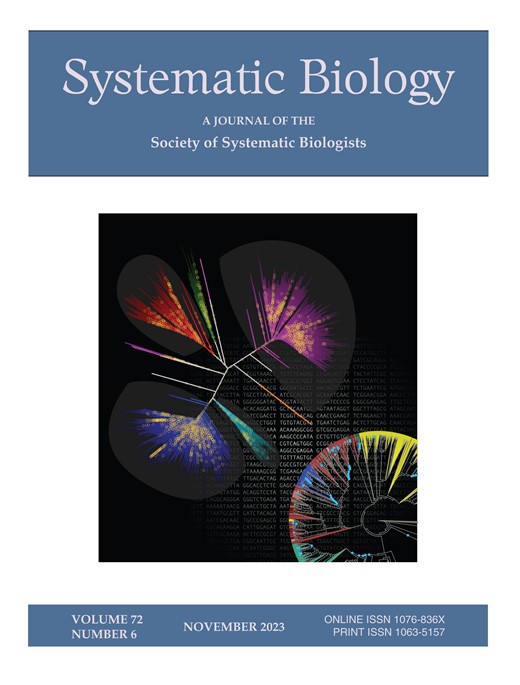The limits of the metapopulation: Lineage fragmentation in a widespread terrestrial salamander (Plethodon cinereus)
IF 6.1
1区 生物学
Q1 EVOLUTIONARY BIOLOGY
引用次数: 0
Abstract
In vicariant species formation, divergence results primarily from periods of allopatry and restricted gene flow. Widespread species harboring differentiated, geographically distinct sublineages offer a window into what may be a common mode of species formation, whereby a species originates, spreads across the landscape, then fragments into multiple units. However, incipient lineages usually lack reproductive barriers that prevent their fusion upon secondary contact, blurring the boundaries between a single, large metapopulation-level lineage and multiple independent species. Here we explore this model of species formation in the Eastern Red-backed Salamander (Plethodon cinereus), a widespread terrestrial vertebrate with at least six divergent mitochondrial clades throughout its range. Using anchored hybrid enrichment data, we applied phylogenomic and population genomic approaches to investigate patterns of divergence, gene flow, and secondary contact. Genomic data broadly match most mitochondrial groups but reveal mitochondrial introgression and extensive admixture at several contact zones. While species delimitation analyses in BPP supported five lineages of P. cinereus, genealogical divergence indices (gdi) were highly sensitive to the inclusion of admixed samples and the geographic representation of candidate species, with increasing support for multiple species when removing admixed samples or limiting sampling to a single locality per group. An analysis of morphometric data revealed differences in body size and limb proportions among groups, with a reduction of forelimb length among warmer and drier localities consistent with increased fossoriality. We conclude that P. cinereus is a single species, but one with highly structured component lineages of various degrees of independence.元种群的极限:一种广泛分布的陆生蝾螈(Plethodon cinereus)的种系破碎现象
在近缘物种的形成过程中,分化主要是由异源繁殖和基因流动受限造成的。广泛分布的物种蕴藏着不同的、地理上截然不同的亚系,这为我们了解物种形成的常见模式提供了一个窗口。然而,初生亚系通常缺乏生殖障碍,无法在二次接触时进行融合,从而模糊了单一大型元种群级亚系与多个独立物种之间的界限。在这里,我们探讨了东红背大鲵(Plethodon cinereus)物种形成的这一模式,东红背大鲵是一种广泛分布的陆生脊椎动物,在其整个分布区至少有六个线粒体支系。利用锚定杂交富集数据,我们应用系统发生组和种群基因组方法研究了分化、基因流和二次接触的模式。基因组数据与大多数线粒体群大体吻合,但也揭示了几个接触区的线粒体引入和广泛混杂。虽然 BPP 中的物种划分分析支持 P. cinereus 的五个系,但系谱分异指数(gdi)对是否包含混杂样本和候选物种的地理代表性高度敏感,当去除混杂样本或将取样限制在每个组的单一地点时,对多个物种的支持度会增加。对形态计量数据的分析表明,各组之间的体型和肢体比例存在差异,在温暖和干燥的地方,前肢长度缩短,这与穴居性增加一致。我们的结论是,P. cinereus 是一个单一的物种,但具有不同独立程度的高度结构化的组成品系。
本文章由计算机程序翻译,如有差异,请以英文原文为准。
求助全文
约1分钟内获得全文
求助全文
来源期刊

Systematic Biology
生物-进化生物学
CiteScore
13.00
自引率
7.70%
发文量
70
审稿时长
6-12 weeks
期刊介绍:
Systematic Biology is the bimonthly journal of the Society of Systematic Biologists. Papers for the journal are original contributions to the theory, principles, and methods of systematics as well as phylogeny, evolution, morphology, biogeography, paleontology, genetics, and the classification of all living things. A Points of View section offers a forum for discussion, while book reviews and announcements of general interest are also featured.
 求助内容:
求助内容: 应助结果提醒方式:
应助结果提醒方式:


